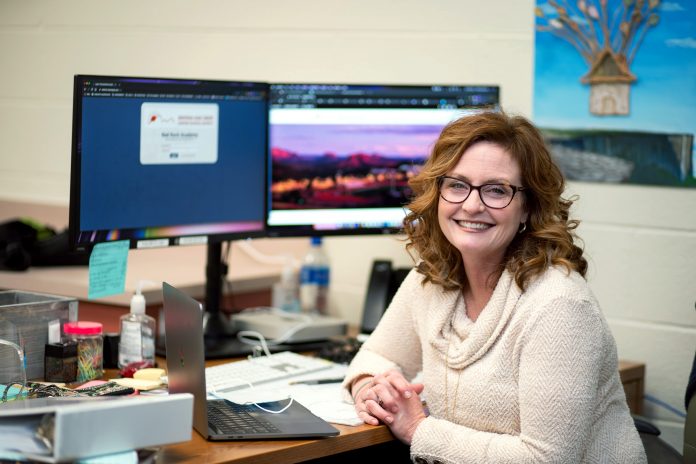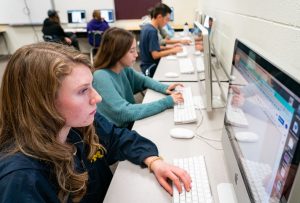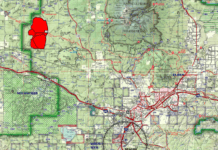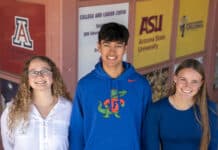
Since the option for students to return to live classes at Sedona-Oak Creek School District became available on Aug. 24, more students have made the transition from online to in-person learning.
Around half of eligible students from the campuses were back three months ago, and SOCSD Superintendent and Sedona Red Rock High School Principal Dennis Dearden says that number is now up to about 90%.
The exact numbers fluctuate daily, as students can interchange between online and in-person, and are asked to attend virtually on days that they are feeling ill in the slightest. All students received a Chromebook to borrow for the school year in the event they need to work from home.
Since August, Dearden has been a proponent for students who are physically healthy to return in-person, and he made the point again at the Tuesday, Nov. 10, school board meeting.
“We have felt very strongly since the very beginning, as [Yavapai County Community Health Services Director] Leslie Horton has, kids need to be in school,” he said. “We feel more strongly now that kids are doing a good job and are healthier here, being around their peers, being around their teachers, being motivated by their teachers.”
However, the 10% of regularly enrolled students who are still opting to learn remotely may not decide to switch back, and the percentage could increase again with COVID-19 spikes in the future. The district is having to figure out how to prepare for virtual learning in the long term.
“No matter how well we do it, it’s stressful on our teachers,” Dearden said of the synchronous in-person and virtual approach that is currently place with all the classes. “We know it’s probably a wave of the future. We’re OK with that. That’s why it’s important for us to get cutting-edge technology, so that teachers are less stressed in the classroom in terms of providing both virtual and in-person at the same time. It’s difficult.”
Dearden said that they have been looking into attaining Audio Enhancement technology for the district that would include installations of speaker systems in each classrooms and microphones for teachers in order to make the virtual experience better. He noted that it would be very expensive, but he also said that the district would soon be getting a $5,000 donation from APS which could help, and the larger investment may be worth it if it draws in new students. Two teachers have volunteered to try out a pilot version.
Originally, the virtual learning experience was supposed to be just like being in the classroom, with the teachers’ video and audio being recorded live via Google Meets on the teacher’s laptop. But not all teachers were on the same technology curve, and SOCSD Assistant Superintendent Deana DeWitt said there have been complaints from the virtual learners about audio being hard to hear when teachers move around the room. Teachers are also having to speak louder, which DeWitt said can be tiring for them.
Other Virtual Options
Over the summer, the district also made a new joint position: Coordinator of Online & English Learning Instruction. Brenda Cady started in this role at the start of the school year, but resigned in mid-September. Mindy Patterson was hired soon after, moving from the Phoenix area to Cottonwood.
“I recently obtained my administrative degree and saw that this position was posted,” Patterson said. “I was excited about the prospects of a district-level position, but also the opportunity to continue to work with students.”

Patterson heads Red Rock Academy, the district’s 100% remote-learning program that was in place a decade before COVID hit. The district made the program available to K-8 students over the summer, whereas it was only available for high schoolers before.
“As the director of online instruction, I provide instructional support for students, whether it is homework help or guidance in navigating the program,” Patterson said. “I also keep track of their progress and attendance. I work quite a bit with parents as well so they can help their child at home.”
There are 21 students currently enrolled in RRA, with four K-8 students, DeWitt said. There was one kindergartener who started, but has now withdrawn.
“I can tell you from my experience with kindergarten students doing online learning, there are many challenges,” Patterson said. “RRA is an online program that navigates students through a preset curriculum. Parents would be responsible for helping their child to pull up their course work and stay focused while they are online. I can provide help with their assignments and give suggestions with their lessons, but I am not actually physically teaching the lessons. It is completely online.”
Patterson has spent years working in Title I schools and worked as an instructional coach in the Phoenix valley for three years before SOCSD.
“When COVID-19 hit, all of us went to the online format and I worked with teachers and students as an instructional coach in that format,” she said. “Online teaching and learning can have its challenges and requires a lot of discipline. I hope that I can instill in students the motivation and dedication to keep persevering in an online environment.”
Along with virtual classroom learning, and learning fully online with Red Rock Academy, 74 students are also utilizing the online credit advancement or credit recovery programs, while others are completing Yavapai College classes through dual enrollment in-person or their online early college programs. However, the amount of students at RRA has actually gone down from last year despite the addition of allowing K-8. DeWitt attributes it to some students transferring out of RRA and into the regular district to do their virtual learning with a teacher.
“When it comes to technology, there are always going to be problems once in a while,” Patterson said. “Sometimes, depending on what type of software students have at home, creating presentations or doing projects can present challenges, but I have found that there are many ways for students to show what they have learned and we can usually work around those challenges.”




















